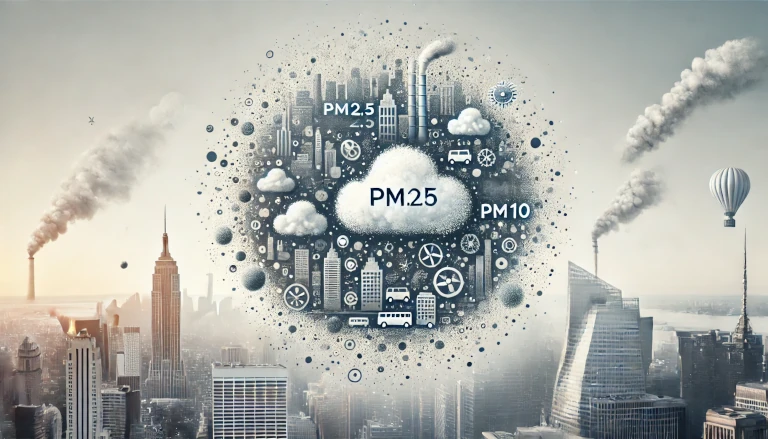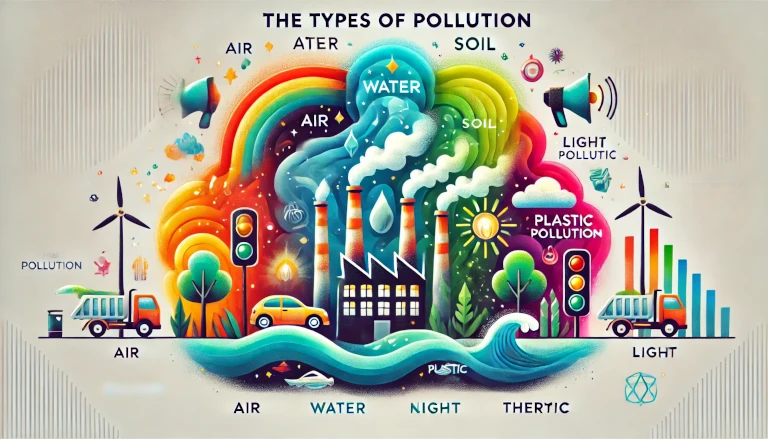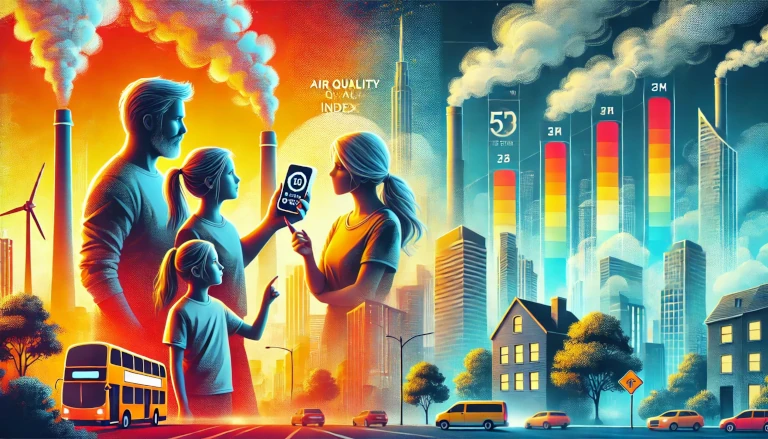Particulate Matter (PM) refers to tiny particles or droplets in the air that can be harmful when inhaled. These particles come in various sizes and can include dust, dirt, soot, smoke, and liquid droplets. Particulate matter is categorized into two main types: PM10 (inhalable particles with diameters 10 micrometers and smaller) and PM2.5 (fine particles with diameters 2.5 micrometers and smaller). Because of its small size, PM2.5 can penetrate deep into the lungs and even enter the bloodstream, causing serious health issues.
What is Particulate Matter ? 🧐
Particulate Matter (PM) is a mixture of solid particles and liquid droplets found in the air. Some particles, such as dust, dirt, and smoke, are large or dark enough to be seen with the naked eye, while others, such as PM2.5, are so small that they can only be detected using microscopes. These particles can come from a variety of sources, including natural and human-made activities.
Why Particulate Matter is Dangerous? ⚠️
Particulate matter poses a significant risk to human health. The smaller the particles, the more dangerous they are, especially PM2.5. These fine particles can reach deep into the lungs and even enter the bloodstream, leading to health conditions such as:
- Respiratory Issues: PM2.5 is linked to asthma, bronchitis, and other lung diseases.
- Cardiovascular Problems: Long-term exposure can lead to heart attacks, strokes, and cardiovascular diseases.
- Premature Death: Studies show that long-term exposure to high levels of PM is associated with premature deaths due to respiratory and heart conditions.
Sensitive groups, such as children, the elderly, and people with pre-existing health conditions, are at greater risk.
How Does Particulate Matter Form? 🌍
Particulate matter can originate from various sources, including:
- Natural Sources: These include dust storms, wildfires, and volcanic eruptions.
- Human Activities: Human activities like burning fossil fuels, industrial processes, and vehicle emissions are significant contributors to PM2.5 and PM10 pollution.
Where is Particulate Matter Most Common? 🌆
Particulate matter is more prevalent in areas with:
- Heavy traffic and industrial activity: Urban areas with high vehicle emissions and industrial factories are major sources of PM.
- Rural areas with agricultural activity: Dust from soil and pesticides can contribute to particulate pollution.
- Regions with wildfires or dust storms: Natural events like wildfires can release large amounts of particulate matter into the air.
When is Particulate Matter Most Dangerous? 📅
The concentration of particulate matter tends to be higher during the following periods:
- Winter months: In many cities, the burning of fossil fuels for heating, combined with stagnant air during cold weather, leads to higher levels of PM.
- Wildfire seasons: During periods of wildfires, large quantities of PM2.5 are released into the atmosphere, significantly reducing air quality.
- Peak traffic hours: Urban areas experience higher levels of PM during times of high traffic due to emissions from vehicles.
How Much PM is Considered Harmful? ⚖️
Particulate matter levels are often measured using the Air Quality Index (AQI). According to the AQI scale:
- 0-50 (Good): Air quality is satisfactory, with little to no health risks.
- 51-100 (Moderate): Air quality is acceptable, but sensitive individuals may experience minor health effects.
- 101-150 (Unhealthy for Sensitive Groups): Sensitive groups, such as the elderly or those with pre-existing conditions, may experience health effects.
- 151-200 (Unhealthy): Everyone may begin to experience health effects; sensitive individuals may experience more serious effects.
- 201-300 (Very Unhealthy): Health warnings of emergency conditions; the entire population is likely to be affected.
- 301-500 (Hazardous): Serious health effects; emergency conditions for the entire population.
Advantages of Reducing Particulate Matter 🌟
- Health Benefits: Reducing PM levels improves air quality and lowers the incidence of respiratory and cardiovascular diseases.
- Environmental Protection: Lowering PM helps protect ecosystems and wildlife from the harmful effects of air pollution.
- Economic Savings: Reducing air pollution leads to fewer hospital visits and lower healthcare costs associated with pollution-related illnesses.
Disadvantages of Not Controlling Particulate Matter ❌
- Increased Health Risks: Prolonged exposure to high PM levels can lead to chronic illnesses and premature deaths.
- Reduced Quality of Life: Air pollution caused by PM can diminish the quality of life, making outdoor activities hazardous, particularly for vulnerable populations.
- Economic Costs: High pollution levels lead to lost productivity due to illness, higher healthcare costs, and lower tourism revenue.
Cost Benefits of Reducing PM 💸
Investing in reducing particulate matter pollution has long-term cost benefits, including:
- Reduced Healthcare Costs: Fewer people suffering from pollution-related illnesses means lower medical expenses for individuals and governments.
- Increased Productivity: Healthier populations lead to higher productivity at work, which benefits the economy.
- Cleaner Environment: Reducing pollution leads to healthier ecosystems, benefiting industries like farming, fishing, and tourism.
How Can We Reduce PM ? 🌿
Several steps can be taken to reduce particulate matter in the air:
- Promote Clean Energy: Transitioning from fossil fuels to renewable energy sources such as solar and wind power can drastically cut down on particulate matter emissions.
- Improve Public Transportation: Encouraging the use of electric buses, carpooling, and cycling can reduce vehicle emissions, a significant source of particulate pollution.
- Use Air Filters: For indoor spaces, using high-quality air filters and purifiers can reduce the amount of particulate matter inside homes and offices.
The Importance of Managing PM 🌎
Particulate matter poses a serious threat to both human health and the environment. Understanding the risks, sources, and methods of reducing PM is crucial in maintaining a healthy atmosphere and improving the quality of life for future generations. Governments, industries, and individuals all play a role in addressing this pressing issue.
Understanding and reducing particulate matter is key to improving air quality, protecting health, and ensuring sustainable living.
Discover more from Green Ecosystem - Renewable Energy, Agriculture, and Environmental Sustainability
Subscribe to get the latest posts sent to your email.


